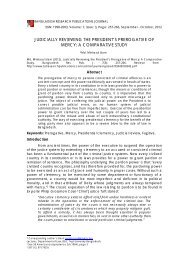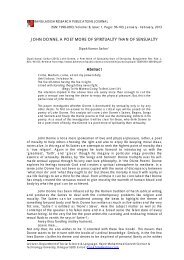Continuous Teacher Development Through Reflective Teaching
Continuous Teacher Development Through Reflective Teaching
Continuous Teacher Development Through Reflective Teaching
You also want an ePaper? Increase the reach of your titles
YUMPU automatically turns print PDFs into web optimized ePapers that Google loves.
Harun and Al-Amincondition of classroom practice then onward. It is always better to carry on actionresearch in group; as one individual may not notice all important aspects of a particularclass. If such a kind of research and reflection are carried on in a group mode, then it ispossible for practitioners to ruminate on various aspects of the classes that one individualfails to do.Nunan(1992) defines action research as,“A form of self –reflective inquiry carried out by practitioners, aimed at solvingproblems, improving practice, or enhancing understanding. It is oftencollaborative.”(Nunan: 229)Kemmis and McTaggart (1988) talk about three defining characteristics of actionresearch. These are (a) it is carried out by practitioners (for our purpose, classroomteachers) rather than outside researchers; (b) it is collaborative; and (c) it is aimed atchanging things. They also define action research as a group activity. (cited in Nunan,1992)Cohen and Manion (1985) offer the following features of action research:“first and foremost it is situational; it identifies and solves problem in a specificcontext. The next feature of action research is that it is collaborative. Lastly, it aimsto improve the state of affairs within the educational context in which the researchis being carried out.” (qtd in Nunan,p.17)Briefly, we can say that action research aims at understanding the teaching and learningsituations; studying the problems related to educational settings, developing thepractitioners’ proficiency and effectiveness that ultimately leads to learners learning thelessons. Hence, we can say that reflective teaching and action research serve the samepurpose i.e. improving language teachers’ classroom practice.The primary responsibility for carrying out action research and deciding on courses ofaction research falls on the practitioners themselves. Hence, action research may veryoften be conducted on self-finance mode i.e. practitioners themselves provide money forcarrying on the research project. And it does not require a huge amount of money.Action Research ModelNunan (1992) also gives seven steps in the action research cycle which are presented anddescribed bellow-Step 1 : Initiation: A teacher comes to the author with a problem: Hiscurrent group of students do not seem interested or motivated. What should be done?Step 2 : Preliminary Investigation : We spent some time collecting baseline data throughobservation and recording classroom interaction.Step 3 : Hypothesis: After reviewing the initial data we formed thehypothesis that the students are unmotivated because the content of the classroom is notaddressing the needs and interest of the students.Step 4 : Intervention: The teacher devises a number of strategies forencouraging the students to relate the content of the lessons o their own backgroundand interest.Step 5 : Evaluation: After several weeks the class is recorded again. There ismuch greater involvement of the students and the complexity of their language andstudent-led interaction is enhanced.Step 6 : Dissemination : The teacher runs a workshop for his colleagues andpresents a paper at a language conference.Step 7 :Follow-up : The teacher investigates alternative methods ofmotivating students.Figure :1.1 Steps in the action research cycle.( After Nunan 1992)From the above figure we firstly, find that the research is initiated by the practitioner and isderived from a real problem in the classroom. Secondly, the research is collaborative--72http://www.bdresearchpublications.com/journal/
















